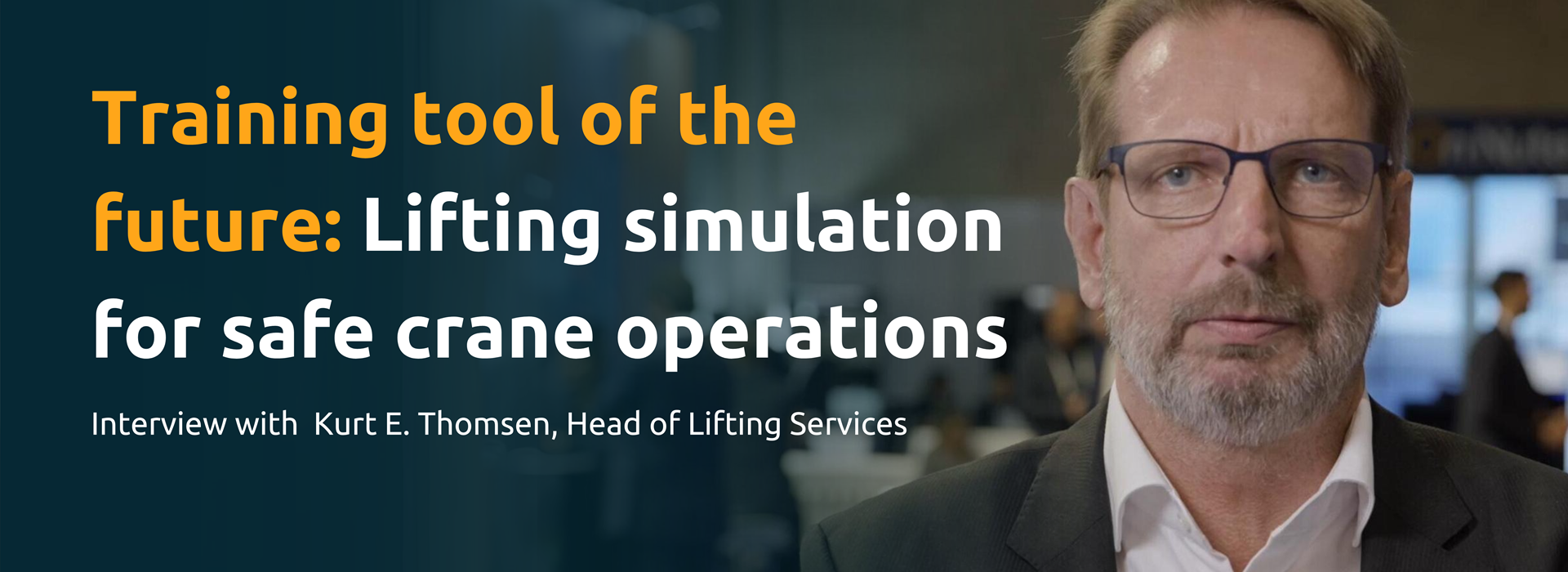Ok
Despite the growing presence of simulator-based training across industries, some skepticism persists regarding its efficacy. Crane operation, a high-stakes field, has seen its share of doubts about the value of simulated training. To address some of these concerns and shed light on the indispensable role of simulators in preparing operators for emergencies and ensuring safety in offshore environments, we interviewed RelyOn Nutec’s Head of Lifting Services, Kurt E. Thomsen. His insights challenge the skepticism, highlighting the unique advantages of simulator-based training in an ever-evolving industry.
Q: “Given the skepticism some professionals express about the effectiveness of simulator-based training, how do you address their concerns or doubts regarding the value and efficacy of simulator training, especially in comparison to traditional training methods?”
Thomsen: “Whenever professional people I meet start questioning the value and sensibility of using crane simulator-based training I always tell them the following analogy: If simulator training did not work, airlines and aviation authorities would not demand pilots take regular training passes in them. As simple as that! That logic is compelling to most people. Why would we insist on training in a simulator if time could be spent more valuably in the airplane itself? The answer is – again – simple.
What kind of training do pilots do in the simulator? Flying in a straight line in a blue sky, all going smoothly? Of course not. They train for emergencies; they train for taking off and landing (Which is the hard part. I know, I fly a bit myself. Only simulators nowadays, by the way). They train recent scenarios that either went wrong, near misses or new methodologies for planes, air traffic control etc. In essence, a lot of things you could not train in a living environment. The same training goes on for Ship navigators, ROV pilots and – of course – crane operators.”
Q: “That seems logical. So how exactly do simulators help crane operators in their training and what is the main reason they are being used?”
Thomsen: “Training what to do when things go wrong, or when something unplanned happens, has enormous value. Lifting and lowering stuff from one place to the other is the lowest level of confidence training there is. Emergency procedure and behavior is crucial training for the offshore environment and certainly the behavior when something unplanned happens is valuable. So, it is clear that when you plan your training program, you must consider what the outcome should be. Just the practice of moving stuff from A to B is probably the least valuable time spent in the simulator. Training accident scenarios of all kinds, previously experienced accident scenarios or near miss situations will prepare the crane operator for the future and, inherently, increase safety. And that is ultimately the reason for training. Increasing safety. There are some issues to consider though.”
Getting the “reality” right
Q: “So in your opinion, what are some of these issues one has to consider when working with simulators?”
Thomsen: “Getting the behavior of the simulator right is the most important thing. If it does not feel and look like a real crane, you quickly become disinterested and treat it like a video game. This is no small feat. Moving the crane with load in a marine environment and keeping all factors correct in real time requires a lot of processing power. And making it look and feel right on top is difficult, since we are asking the processor to move loads in an extremely specific way but asking it to express this in mathematical equations expressed in programming lines. But this is the important part. If it feels wrong, a reasonably experienced crane operator will immediately detect the flaws. I have spent nearly four decades working with cranes in various capacities, so believe me, I know how important it is to get it right.”
Q: “Based on this experience, what can be done to avoid programming simulators with flaws that don’t provide the real-world feel?”
Thomsen: “Working closely with the programmers will increase the realistic experience dramatically. And being an experienced crane operator is not enough. You must be able to communicate what you want to the programmer in a way he can actually process it into the computer. However, when it works it makes a stark difference. Getting the Real world look right is also important. Crude pixeled images of what you are working with are outdated. Working with graphics programs which can accommodate the complexity of the operational environment where the crane is operating is paramount. The result of working with a good graphics program is, however, game changing in terms of operator experience when in the simulator. This makes or breaks the training experience and adds or detracts from the outcome.”
Getting the exercises right
Q: “Apart from ensuring that the programming and graphics work correctly, are there any other aspects that should be considered when working with simulators?”
Thomsen: “It is also of great importance that the exercises in the simulator are relevant. As stated above, moving containers from A to B is the lowest level of competence. So, offshore cranes will have the added complexity of sea-states and currents. When the crane is on a fixed platform this adds complexity level 1 to the loading un-loading exercises. When the crane is on a moving platform the level is increased considerably since everything is now moving. Loading and unloading is of course the bread and butter of the crane operation, and surely adding emergency scenarios to this is of value.
So, considering the trainee might have no, or little, prior experience, it is of course relevant to start off simply. The trainee must start by understanding how the crane operates. Thus, completing simple tasks and learning the movements of the crane and joysticks. But since the time available is limited, the complexity must increase fairly rapidly. Thus, you should get into the “daily” tasks of the operator quickly and – ironically – start moving containers and items from deck to platform and vice versa. The simulator is ideally suited to this type of training.”
Q: “Can you describe in more detail how simulator training helps crane operators develop and validate these essential skills needed in their daily work life?"
Thomsen: “The trainee will get a feel for the operation and length of concentration required to carry out the loading/unloading operation. This will enable them to validate their own skill, hand/eye coordination and attention span, which by the way is required to be significant. You work with big heavy loads in a dangerous environment and with people in the near vicinity who cannot “just get away” in case of an unplanned incident. Luckily this is where the real benefit of the simulator comes in. With the help of a simulator, we can restart and do things over and over again, until we arrive at the desired behavior. In real life, this is not achieved so quickly. Logically, because the approach must be much more structured and careful.”
Q: “Finally, if you had to pinpoint what really differentiates simulator training form other forms of training, what would you say the most significant difference is?”
Thomsen: “The most interesting aspect of the simulator is that it allows us to test ourselves and our behavior when experiencing incidents. Unplanned – of course – they need to come as a surprise and our reaction to the incident must be worked, or trained, into the operators in a way that they pretty much react before realizing the incident has occurred. This is where the simulator can really make a difference. Let us say a leg snaps in a four-legged bridle when lifting a 20-foot container onto the deck of the supply vessel. We can replicate this scenario in a simulator and ask the trainee to land the container safely. Without a simulator, they would have to do that in real life. But as this would be too dangerous of course, these scenarios cannot be trained in real life. To still train these critical scenarios, the simulator has built in “malfunctions” and faults that can occur when operating, at any time and with no warning to the operator. That is where we work like the airline pilot who is also training for unplanned incidents – and not flying in a straight line. And that is the value of simulators, exactly.”
Simulator training focuses on handling unforeseen situations and emergencies, which are crucial for safety in high-risk environments. Drawing parallels with aviation training, where simulators are essential for preparing pilots for emergencies, Thomsen sheds light to how simulators can enable operators to practice and react to real-world incidents, ensuring competency and safety in crane operations. Providing a high-quality 3D visualization of port, RelyOn Nutec’s crane simulators offer an unparalleled level of realism and a very user-friendly interface, aligning with our objective to deliver safety and competence services across the world, and to help our customers protect their people, assets, and the environment.
Check out our Lifting Simulation webinar by Kurt Thomsen to learn more about the technology behind our lifting simulators and the benefits of training with one.
Next read
-

-

-
 Article 14. June 2024
Article 14. June 2024 -

Ensuring Safety and Efficiency: IRATA Rope Access Training for a Safer Work Environment
In industries such as oil & gas and renewables, where accessing challenging locations is common, rope access methods provide a safe and efficient solution. These methods offer technicians a secure means of navigating heights and restricted areas while minimizing environmental impact. However, proficiency in rope access requires proper training and a globally accepted safety education.
Article 4. June 2024 -

Polaris Sells RelyOn Nutec to Mubadala Capital
The acquisition, part of Mubadala Capital’s flagship Private Equity Fund IV, strengthens the asset manager’s footprint in the business services sector.
Article 24. May 2024 -

RelyOn Nutec Acquires Electrical Training and Consultancy Specialist Quercus Technical Services, Fast-tracking European Electrical Capability Build
Effective May 21st, RelyOn Nutec has acquired Quercus Technical Services BV, one of the largest specialist electrical safety and skills training organizations in the Netherlands. The acquisition of Quercus bolsters RelyOn Nutec’s position in the electrical training market and accelerates its European roll out.
Article 22. May 2024 -

-
 Article 2. May 2024
Article 2. May 2024
